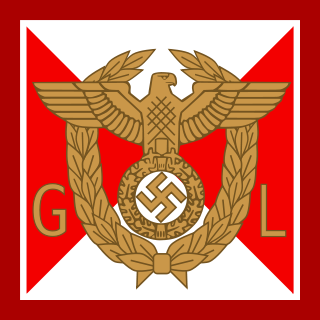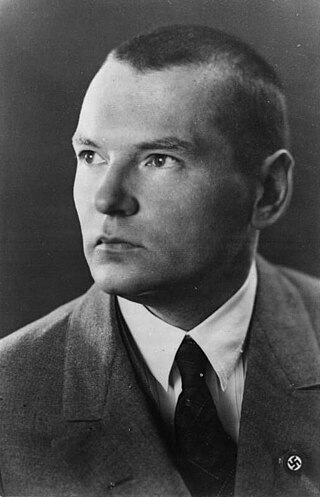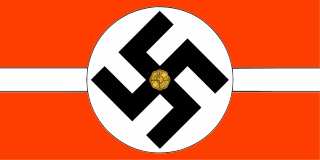
Inspekteur (inspector) was a Nazi political rank that existed briefly in 1932 in a reorganization promulgated by Gregor Strasser, the Reichsorganisationsleiter (Reich Organizational Leader) of the Nazi Party since January 1928.

Inspekteur (inspector) was a Nazi political rank that existed briefly in 1932 in a reorganization promulgated by Gregor Strasser, the Reichsorganisationsleiter (Reich Organizational Leader) of the Nazi Party since January 1928.
Strasser largely had been given free rein to organize and structure the Party by Adolf Hitler who was not interested in administrative detail and mundane day-to-day organizational concerns. [1] Strasser sought to consolidate and centralize the organizational structure by imposing an additional layer of supervision on the then existing 44 Gauleiters in Germany and Austria. Strasser sought to improve organizational control of the Party throughout the country ahead of the upcoming 31 July 1932 election to the German Reichstag. The overall objective was to give the Party the kind of organisational structure that would allow it to contest the election in a more effective and disciplined manner. [2]
On 15 July 1932, the Party Gauleiters were subordinated to ten new officials titled Landesinspekteurs, each with oversight responsibilities for several Gaue within a specified geographic area. (See tables.) These new Landesinspekteurs were taken from the ranks of the existing Gauleiters, and vacated their Gau posts. Most were trusted colleagues of Strasser, and had worked with him when he was a principal organizer of the Party in northern Germany in the early 1920s. [3] These Landesinspekteurs, in turn, reported to one of two new Reichsinspekteurs, either Paul Schulz or Robert Ley, both of whom served as close protégés of Strasser in the Party's Reichsleitung (Reich Leadership Office) in Munich. [4]
The Landesinspekteurs were independent agents, given the authority to conduct surprise Gau inspections day or night, without advance notice. They also were given the authority to supersede the Gauleiters’ directives, if necessary. The new organization was opposed by many Gauleiters, as it imposed additional layers of Party bureaucracy between them and Hitler. They always had considered themselves as Hitler’s direct agents in their jurisdictions, and were used to reporting directly to him. [5]
The position of Inspekteur was denoted on Nazi Party brown shirts by either one of two collar bars worn on a dark red collar patch. The shoulder boards were also paired up with a one or two knotted gold shoulder cord.
On 8 December 1932, Strasser resigned as Reichsorganisationsleiter in a major policy dispute with Hitler over the future direction of the Party. By 15 December, Hitler announced that he was temporarily assuming the duties of Reichsorganisationsleiter, with Robert Ley as Chief of Staff. [6] Paul Schulz followed Strasser into retirement. In seeking to eradicate Strasser’s legacy, Hitler decreed a thorough revocation of the recent administrative reforms. He further reconfirmed the Gauleiters’ status as his personal agents. The positions of Landesinspekteur and Reichsinspekteur were abolished. All ten Landesinspekteurs were returned to their former Gauleiter positions. [7] Thus, the new organizational scheme did not survive Strasser's fall, and these two Inspekteur ranks disappeared from the Party organization.
| Landesinspekteur | Area | Gaue |
|---|---|---|
| Joseph Goebbels | Berlin | Berlin |
| Helmuth Bruckner | East | Danzig, East Prussia, Silesia |
| Bernhard Rust | Lower Saxony | Eastern Hanover, Southern Hanover-Brunswick, Weser-Ems, Westphalia-North, Westphalia-South |
| Wilhelm Friedrich Loeper | Middle Germany-Brandenburg | Brandenburg, Eastern March, Halle-Merseburg, Magdeburg-Anhalt |
| Hinrich Lohse | North | Hamburg, Mecklenburg-Lübeck, Pomerania, Schleswig-Holstein |
| Landesinspekteur | Area | Gaue |
|---|---|---|
| Theodor Habicht | Austria | Carinthia, Lower Austria, Salzburg, Styria, Tyrol, Upper Austria, Vienna, Vorarlberg |
| Robert Ley, Acting | Bavaria | Lower Bavaria-Upper Palatinate, Lower Franconia, Middle Franconia, Munich-Upper Bavaria, Rhine Palatinate, Swabia, Upper Franconia |
| Martin Mutschmann | Saxony-Thuringia | Saxony, Thuringia |
| Jakob Sprenger | Southwest | Baden, Hesse-Darmstadt, Hessse-Nassau North, Hesse-Nassau South, Württemberg-Hohenzollern |
| Heinrich Haake | West | Dusseldorf, Essen, Koblenz-Trier, Cologne-Aachen, Saarland |

Robert Ley, a German politician and labour-union leader during the Nazi era, headed the German Labour Front from 1933 to 1945. He also held many other high positions in the German Nazi Party, including Gauleiter, Reichsleiter and Reichsorganisationsleiter. He committed suicide while awaiting trial at Nuremberg for crimes against humanity and war crimes.

A Gauleiter was a regional leader of the Nazi Party (NSDAP) who served as the head of a Gau or Reichsgau. Gauleiter was the third-highest rank in the Nazi political leadership, subordinate only to Reichsleiter and to the Führer himself. The position was effectively abolished with the fall of the Nazi regime on 8 May 1945.

Gregor Strasser was an early prominent German Nazi official and politician who was murdered during the Night of the Long Knives in 1934. Born in 1892 in Bavaria, Strasser served in World War I in an artillery regiment, rising to the rank of first lieutenant. He joined the Nazi Party (NSDAP) in 1920 and quickly became an influential and important figure. In 1923, he took part in the abortive Beer Hall Putsch in Munich and was imprisoned, but released early for political reasons. Strasser joined a revived NSDAP in 1925 and once again established himself as a powerful and dominant member, hugely increasing the party's membership and reputation in northern Germany. Personal and political conflicts with Adolf Hitler led to his death in 1934 during the Night of the Long Knives.

Bernhard Rust was Minister of Science, Education and National Culture (Reichserziehungsminister) in Nazi Germany. A combination of school administrator and zealous Nazi, he issued decrees, often bizarre, at every level of the German educational system to immerse German youth in Nazi ideology. He also served as the party Gauleiter in Hanover and Brunswick from 1925 to 1940.

Jakob Sprenger was a Nazi Party official and politician who was the Party's Gauleiter of Hesse-Nassau South from 1927 to 1933 and Gau Hesse-Nassau from 1933 to 1945. He was also the Reichsstatthalter and Minister-President of the People's State of Hesse, the Oberpräsident of the Prussian Province of Nassau and an SA-Obergruppenführer.

Martin Mutschmann was the Nazi Regional Leader (Gauleiter) of the state of Saxony during the time of the Third Reich.

Rudolf Jordan was the Gauleiter in Halle-Merseburg and Magdeburg-Anhalt in the time of the Third Reich. After the war, he was sentenced to 25 years in a Soviet Union labour camp. He was released from the camp in October 1955, and died in Munich in 1988.
Wilhelm Friedrich Loeper was a German Nazi politician. He served as the Gauleiter in the Gau of Magdeburg-Anhalt and was the Reichsstatthalter of the Free States of Anhalt and Brunswick

Carl Georg Röver was a German Nazi Party official. His main posts were as Gauleiter of Gau Weser-Ems and Reichsstatthalter of both Oldenburg and Bremen.
Ernst Schlange was a German Nazi Party official and politician who served as Gauleiter of Gross-Berlin and later of Gau Brandenburg. He was also a lawyer and a member of the Prussian Landtag. Severely wounded in World War I, he became active in various anti-Semitic, far right political groups and eventually joined the National Socialist German Worker's Party. He was opposed to the Party's more extreme tactics for gaining power and was a close ally of the Strasser brothers. After their fall from power, Schlange lost his leadership posts by the mid-1930s. He died in Soviet captivity after the end of World War II.
Heinrich “Heinz” Haake was a Nazi Party Gauleiter and government official.
Paul Schulz was a German military officer and Nazi Party official perhaps best known as a leader of the Black Reichswehr in the 1920s.
Josef Klant was an early member of the Nazi Party and served as the first Gauleiter of Hamburg.

Ludolf Haase was a Nazi Party official who served as Gauleiter in Southern Hanover from 1925 to 1928.
Karl Lenz was a Nazi Party (NSDAP) official who served as the third and last Gauleiter of Gau Hesse-Darmstadt. He was also an officer in the Allgemeine SS and the Waffen-SS.
Karl Linder was a Nazi Party (NSDAP) official who served as Gauleiter of Gau Hesse-Nassau South and Gau Hesse-Nassau as well as in many governmental positions, including as Second Bürgermeister of Frankfurt am Main. A member of the Sturmabteilung (SA), Linder held the rank of SA-Brigadeführer.
Bruno Gustav Scherwitz was a German Nazi Party official who served as the Gauleiter of Gau East Prussia in the Party's early years, and as a Luftwaffe officer in World War II.

Bezirksleiter was a Nazi Party title which was used in the early years of the Party's existence, beginning around 1926.
The National Socialist Working Association, sometimes translated as the National Socialist Working Community was a short-lived group of about a dozen Nazi Party Gauleiter brought together under the leadership of Gregor Strasser in September 1925. Its full name was the Arbeitsgemeinschaft der nord- und westdeutschen Gaue der NSDAP. Aligned with the more "socialist" wing of the Party, it unsuccessfully sought to steer the Party leadership in that direction by updating the Party program of 1920. Perceived as a threat to his leadership by Party Chairman Adolf Hitler, its activities were curtailed shortly after the Bamberg Conference of 14 February 1926 presided over by him, and it was formally dissolved on 1 October of that year.

Hermann Franz Arthur Fobke was a Nazi Party official and an officer in the SA. Following the Beer Hall Putsch, he was imprisoned with Adolf Hitler in Landsberg Prison and served during that time as his secretary. From 1925 to 1928, he was the Deputy Gauleiter of Gau Hanover-South. He died on the eastern front during the Second World War.